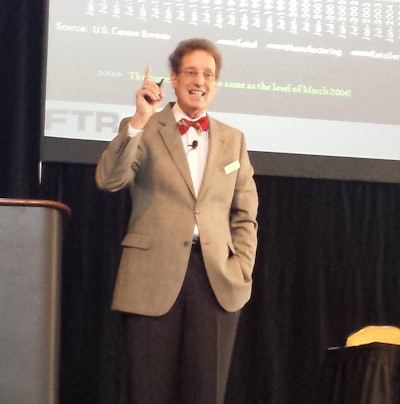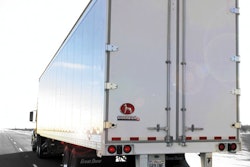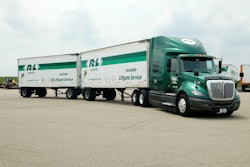 FTR Senior Consultant Noel Perry predicts that carriers’ average driver hiring needs will soar by 36 percent by 2020.
FTR Senior Consultant Noel Perry predicts that carriers’ average driver hiring needs will soar by 36 percent by 2020.The underlying fundamentals of the U.S. economy point to a freight market that probably will continue to improve over the next year or so but not necessarily enough to justify growth in carriers’ truck and trailer fleets. That was the overall message from the first day of the 2013 FTR Transportation Conference in Indianapolis.
The current economic recovery is challenging and frustrating because it is so slow, said Bill Strauss, senior economist for the Federal Reserve Bank of Chicago. Rebounds after deep recessions usually are robust, and the most recent downturn was the worst since the Great Depression. But growth isn’t even half of what you might expect to see after a recession. For example, the annualized growth in Gross Domestic Product during the four years following the bottom of the 1981-82 recession was 5.2 percent. Similarly, GDP grew at an annualized rate of 5.0 percent in the four years after the bottom of the 1974-75 recession.
In the four years since the bottom of the 2008-09 recession, however, the annualized GDP growth rate has been only 2.2 percent — just about what we would have expected had there never been a recession, Strauss said. While the situation is disappointing, it’s not too surprising, Strauss said, contending that recoveries from recessions sparked by financial crises often are softer and slower than usual because capital lending is muted.
Strauss looks for the U.S. economy to expand at about 2.1 percent this year, which is just about trend, and to be slightly stronger at around 2.8 percent in 2014. Manufacturing output — by far the most important driver of trucking activity — also should increase at a pace slightly above trend in 2014, Strauss said.
If this outlook holds, don’t expect much growth in trucking, warned Noel Perry, FTR Senior Consultant and principal of Transport Fundamentals. At 1 to 2 percent GDP growth you don’t see any growth in trucking and perhaps even some contraction, Perry said. A panel of trucking executives later in the morning confirmed this observation; all reported that they have no plans for growth and are being fairly conservative, even with replacement.
FTR sees slower growth for trucking in the next couple of years than in the first three years of the recovery. But trucking isn’t alone in experiencing a sluggish recovery. The only major transportation mode that has exceeded its 2006 peak level is intermodal, Perry said.
Meanwhile, trucking and especially intermodal face some significant challenges, Perry argued. For starters, even if growth over a year or two might be modest, conditions may be volatile from quarter to quarter because industrial production is volatile, and that will require carriers to adjust capacity frequently. Also, the long-term trend toward ever-leaner inventories, which has been a boon to trucking, seems to have ended. “We appear to have exhausted most ways of controlling inventories, and trucking costs will only drive more inventories.”
Another factor that ironically might be a challenge for trucking companies is today’s relatively stable diesel price. Based on his analysis of the data, Perry believes that independent of surcharges carriers had been using fuel price volatility as leverage in pushing for higher freight rates.
On top of these worries, carriers will need to hire many more drivers in the coming years. FTR forecasts that trucking will face a 36 percent increase in average hiring requirements by 2020, Perry said. While some of this increase comes from growth, most of it results from churn, retirements and what Perry calls “regulatory drag” — all the federal regulations, including the recent hours-of-service changes, that carriers will face.
With only replacement demand in sight, the challenges may be about as daunting for the companies that supply the trucking industry. North American Class 8 production likely won’t exceed the 2012 level of 273,000 units until 2015, and even then FTR is forecasting only 275,000 trucks, said FTR President Eric Starks. Truck manufacturers don’t have much backlog; after the fourth quarter of this year their order books for production are quite low. One potential bright spot for truck and trailer manufacturers is that regulatory changes — especially the recent changes to the hours-of-service rules — will negatively impact productivity and will increase demand for equipment as well as drivers.
While the next couple of years will be challenging, the three to five years thereafter promise to be very strong for carriers and equipment suppliers alike, argued Eli Lustgarten, senior vice president of Longbow Securities. Some of the major factors behind Lustgarten’s optimism is the growth in the domestic energy production to the point where United States could become a net energy exporter and the shortening of manufacturing supply chains. “The reshoring/nearshoring phenomenon is real, enhancing a renaissance of American manufacturing,” Lustgarten said.
Just this week, global management consulting firm Boston Consulting Group reported that a majority of major U.S. manufacturers are planning or “actively considering” reshoring. The issue of reshoring/nearshoring will be the featured topic as the FTR Transportation Conference continues this week.










